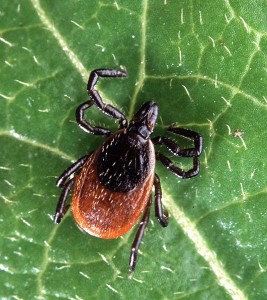How to Protect Against Lyme Disease
There has been a sharp rise in the deer tick population in the past couple of years which has also caused an increase in Lyme disease.
Consequently, we wanted to share some tips from Ehow about how to prevent Lyme disease.
CLOTHING – To obtain some degree of protection against ticks ,you should wear light-colored clothing. Always make sure you wear long sleeve tops, long socks and long pants.
Keep clothing buttoned, keep your shirttail inside trousers and trouser legs inside tops of socks. A ring of masking tape with the sticky side out placed around the tops of boots or shoes will often trap ticks that are ascending to look for an attachment site. Never sit on the ground or on logs in brushy areas.
REPELLANT – Permanent, a tick repellent containing permethrin, may be applied to clothing only (avoid skin contact). This product may provide protection for a day or longer. Repellents containing Deet will protect exposed skin but will not stop ticks from crawling under clothing to reach untreated portions of the body. Applying repellents to the entire body might prevent tick bites for a while, but such extensive treatments often are impractical and may be hazardous to health. Always read and follow the pesticide label instructions.
INSPECTING YOUR DOGS AND CATS – Pets who have been bitten by ticks often bring them to their owners and into their homes. Dogs are probably more likely to get Lyme disease than their owners. Cats are generally less likely to be attacked by ticks than dogs. But, these animals should be inspected periodically and after each outing to suspected tick-infested areas. Ticks can be removed from pets as previously described and with the same precautions.
Flea and tick collars, sprays, dips and shampoos containing permethrin, pyrethrins, chlorpyrifos or other approved acaricides will give small animals some protection.
REMOVAL – Use tweezers or protected fingers, not bare fingers, to remove attached ticks.
Use tweezers or protected fingers, not your bare fingers, to remove attached ticks. Grasp the tick firmly, without crushing it, as near the skin as you can and remove it with a slow, steady pull away from your body. Hasty removal of an attached tick can break off the mouthparts and lead to prolonged inflammation, irritation and possibly secondary infection. Treating the bite with first aid antiseptic will prevent secondary infection. It is advisable to save the tick for identification in the event you later suspect signs of disease. Ticks can be kept alive by placing them in a small bottle with moistened (not wet) paper towel pieces; or they can be killed and preserved in a small container of rubbing alcohol. It will also help if you date the collection and note the geographic location the tick came from.
Photo Source: http://en.wikipedia.org/wiki/File:Adult_deer_tick.jpg





